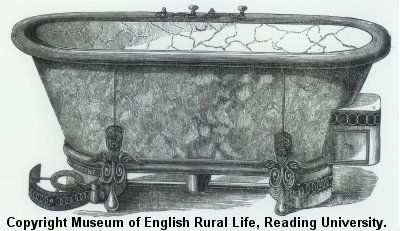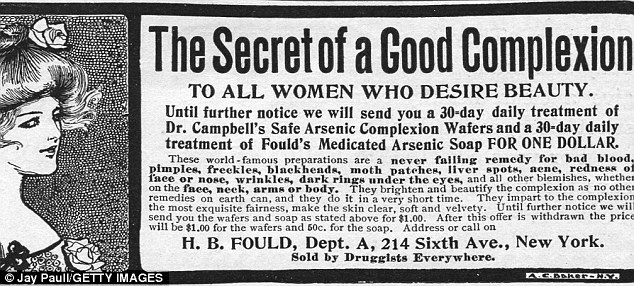As long as there have been bodies, there has been a need to CLEAN those bodies. At some points in history, water was thought to be dangerous and bathing would make you “foul sick” – a common saying was a bath when you were born and one when you died was all you needed. Victorian hygiene was another level entirely.
The Victorians wanted no truck with that “two baths a life” nonsense. They wanted their bodies and surroundings to be CLEAN, dang it – bodies, clothing, homes, everything needed to be CLEAN.

Science had a bit to do with that. You see, for generations it was thought that disease was spread through “bad air” – remember the Plague Doctors stuffing the noses of their masks with sweet smelling herbs? During the late Victorian period, the acceptance of germ theory, especially in Europe, was on the rise, as more advanced microscopes made the invisible microbe visible.

Social conventions had something to do with the Victorian obsession with cleanliness, too. The cleaner the home, the cleaner the clothing, the paler the complexion, the higher class you were, and everyone wanted to climb that ever-present social ladder. There needed to be no whiff of being lower-class human about you!
Grab a cup of coffee (did you clean your coffee pot today?) and see how the Victorians killed themselves in an effort to be sparkling clean.
Gas Bathtubs
The Victorian Age saw more and more homes fitted with gas fixtures. Gas lights were seen as far superior to candle and lantern light, and anyone who was anyone had gas piped into their homes. If you were VERY forward thinking, you might even have yourself a gas heated bathtub!

No. Not a gas heated water heater. A gas heated tub! To go in your height-of-luxury bathroom, with running water! No longer would you have to haul water to a tub that you’d heated in the kitchen; you could have your water heated RIGHT WHERE YOU NEEDED IT. Huzzah! The progress!
These bathtubs had a gas ring underneath the floor of the tub, and you’d fill it with water, light the gas, and climb in. Mind you, there was no adjustable thermostat, no timer, nothing of that sort. Just your bare butt in water over a flame.
It looks a lot like what I used for a crab boil in the backyard, and the newspapers of the time often had stories about people who’d basically boiled themselves to death in their bath.

No thanks, I’ll just smell bad. This was a serious case of “just because you can, doesn’t mean you should”.
Exploding Toilets
Now that homes had running water, the chamber pot was right on out, and the flushing toilet was the latest thing. Victorians didn’t want anything to do with bodily fluids, and to be able to do your business and then wash it away, out of your house and out of your mind, without ever touching it – well, why WOULDN’T you want that?
In their defense, I’m willing to bet folding money that most of you reading this have flushing toilets in your homes.
I’m also willing to bet that they’re not in danger of exploding. The Victorian homeowner couldn’t say that.
Victorian plumbing and sewers weren’t quite up to the mammoth duty (heh, you said doody) that they were presented with. Human waste produces methane and hydrogen sulfide. These gases aren’t only smelly, or at least the hydrogen sulfide is, they’re flammable, and when they built up in the sewers and the pipes, the lack of any sort of plumbing invention to KEEP the gases out of the homes was an issue. Add a lit match, a candle, a cigarette – and boom. There were also explosions in the sewers, since the only way to investigate any sewer blockages was with a lantern or torch.
You can thank Thomas Crapper and his U-bend plumbing trap for helping to put a lid on the exploding loo.
Arsenical Soap and other Insanity
Since you’ve got your heated bath, and your gas lights, you can bathe at your leisure. What are you going to wash yourself with? Victorian hygiene must continue to progress!
Well, the Victorians prized a pale complexion; because of this, there was a huge market for soaps and treatments, especially for women, that promised to impart that pallor. The problem was what manufacturers were using in those soaps and beauty treatments. One of the most popular was arsenic.
Arsenic. You know what arsenic is, right? It’s a poison.

Not only did they use “arsenical soap”, but women (and some men) would take arsenic wafers by mouth. It would supposedly impart a pale glow, and deal with such offending things as pimples. Some women would wash their faces with ammonia, and slather their faces with opium as a sleeping treatment.
I guess if you’re dead you don’t care what you look like?
I don’t know about ya’ll, but I think I’ll stick with my K-beauty skincare, m’kay?
What Victorian hygiene practice do you think is craziest? Comment or drop me a line!
WHAT I’M DRINKING:
Revv “No Surrender” blend – if you like your coffee DARK, you’ll like this one. I’m not a dark afficenado, so I don’t know that I’ll repurchase, but my dad really enjoys it. I did enjoy the caffeine hit: it’s got a LOT of caffeine per serving, so if waking up is your main priority, go for this one.
MUG OF THE DAY:
My mom got me a mug for Christmas; not only is it a sentiment I can truly get behind, it’s roughly the size of my head. The one linked below isn’t EXACTLY the same, but it’s close enough.
FOR FURTHER RESEARCH:
Inside the Victorian Home: A Portrait of Domestic Life in Victorian England, by Judith Flanders
A Victorian Lady’s Guide to Fashion and Beauty, by Mimi Matthews
Some of the links above may be affiliate links; if you chose to purchase any of the products above using the link, I get a little coffee money. It costs you nothing to use the link, and thank you if you do!